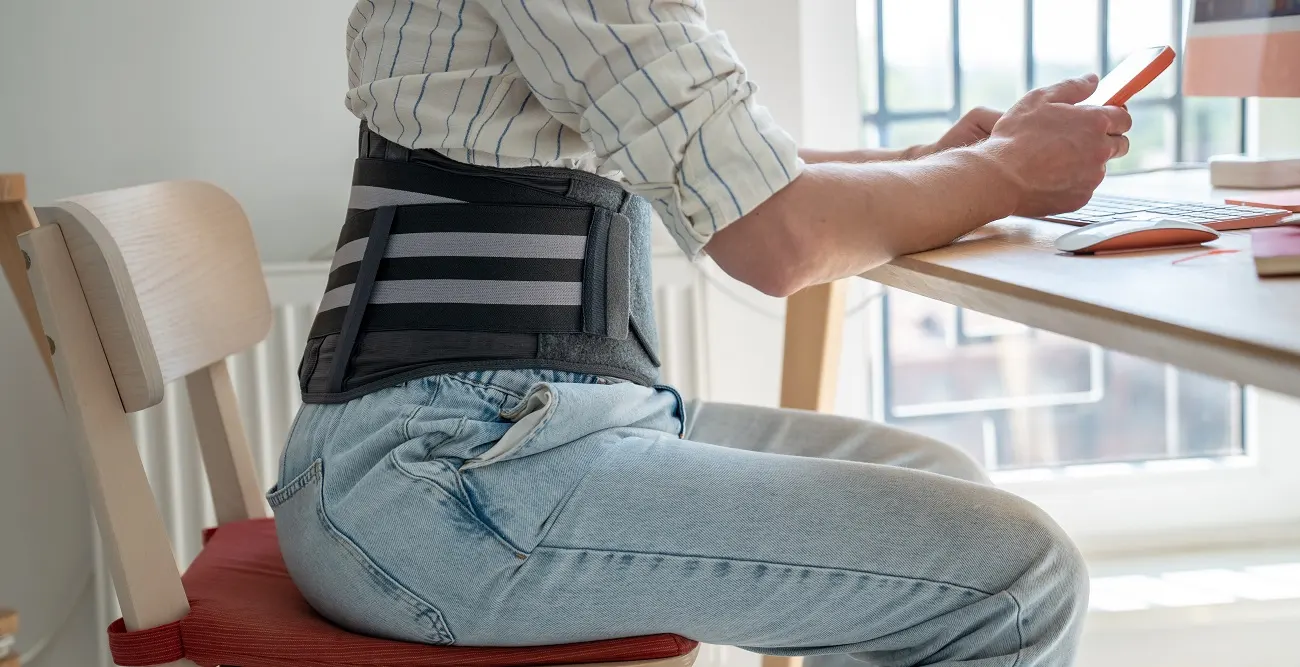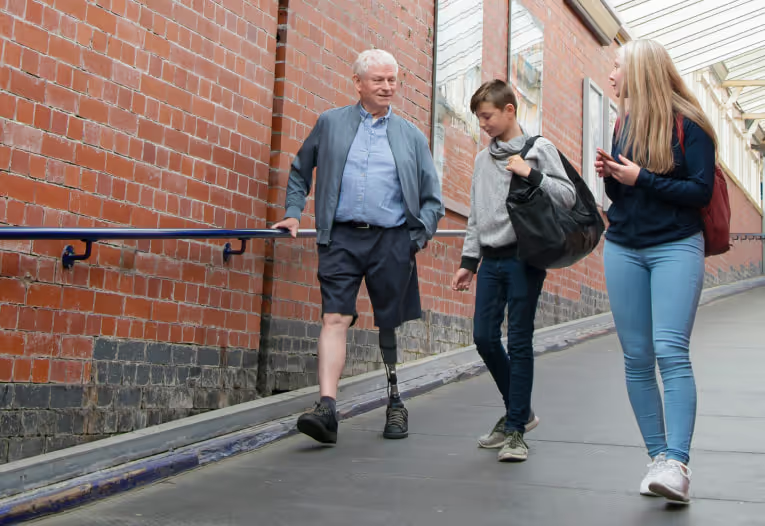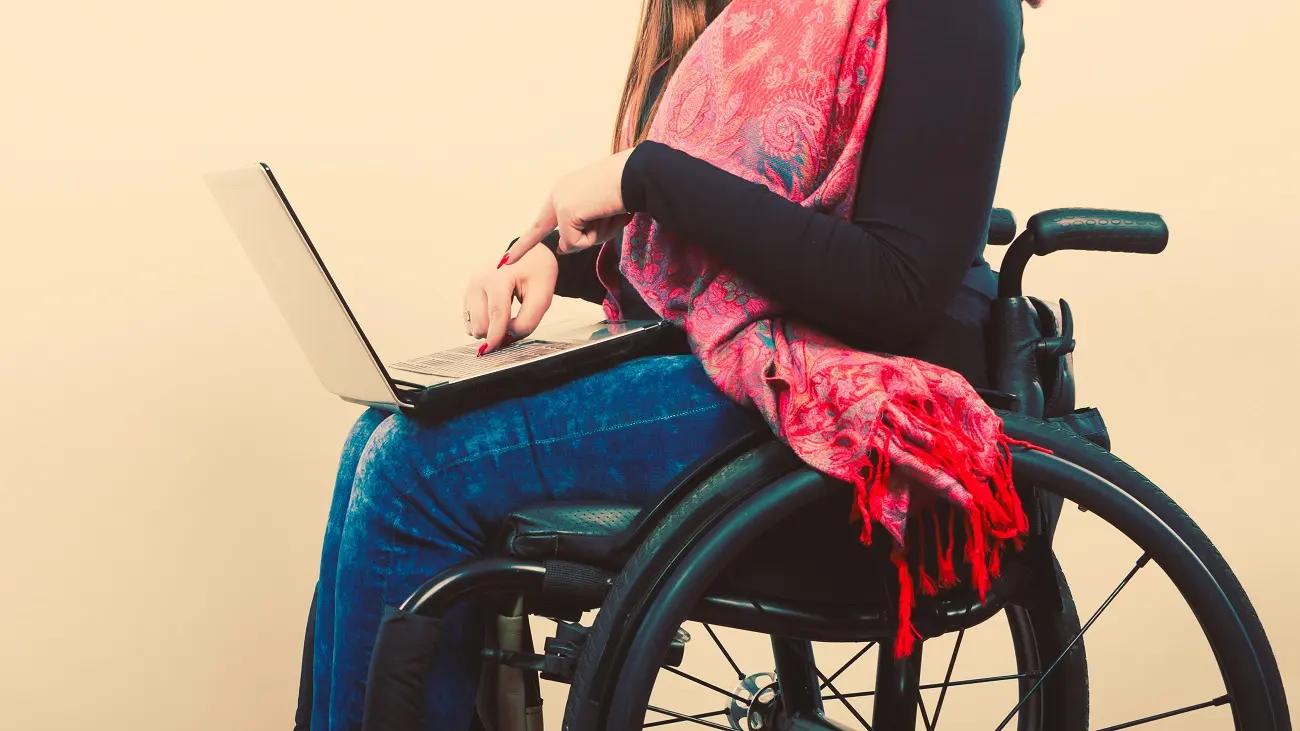Back pain affects millions of people daily, making even simple tasks feel overwhelming and painful. Whether you're recovering from back surgery, managing chronic pain, or seeking additional support during physical activities, a back brace can provide significant relief.
At PrimeCare, New Mexico's leading provider of custom back braces, we've helped thousands of patients reduce pain through custom back braces. Our specialists know that wearing a back brace correctly makes all the difference between pain relief and ongoing frustration.
Back Braces: More Than Just Support
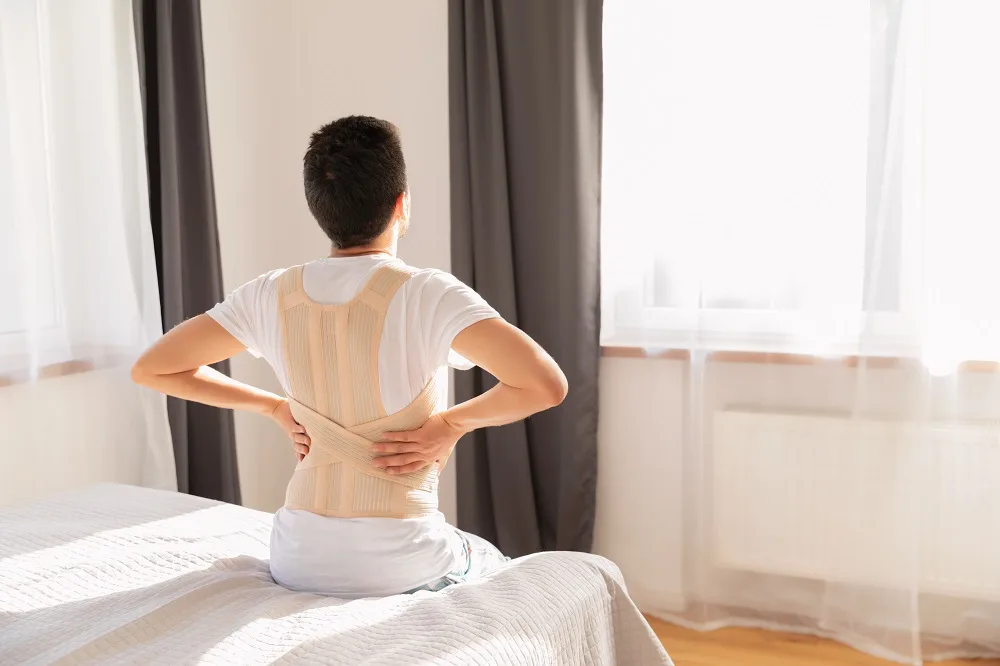
A back brace is a type of orthosis that serves as an external support system for your spine, helping to maintain proper alignment while reducing strain on your back muscles and providing pain relief. These devices come in various designs to target specific conditions and provide different levels of support. Whether you're dealing with chronic back pain, recovering from surgery, or need additional support during heavy lifting, selecting the right type of brace makes a significant difference in your treatment plan.
Here are the main types of back braces:
- Rigid braces limit movement significantly and are often prescribed after back surgery or for serious spinal conditions, including specialized options like TLSO (Thoracic-Lumbar-Sacral Orthosis) braces. They support the entire mid-to-lower spine, and CTO (Cervical-Thoracic Orthosis) braces extend support from the neck through the upper back. These braces help achieve skeletal maturity in growing patients and provide maximum stability during the healing process.
- Semi-rigid braces offer moderate support with some flexibility for daily activities. They’re commonly used for conditions requiring stabilization without complete immobilization, such as LSO (Lumbar-Sacral Orthosis) designs that focus on lower back support while allowing some natural movement. These help prevent further injury while maintaining functionality.
- Flexible lumbar braces provide gentle compression and support for muscle tension relief. They’re ideal for managing chronic conditions or providing additional support during physical activities without restricting the range of motion. Most braces in this category work well for daily wear and help improve posture naturally.
- Posture correctors are designed to pull back the shoulders and encourage proper spinal alignment. They range from simple elastic designs to more structured supports that address both thoracic and lumbar regions. These devices remind wearers to maintain good posture throughout the day.
Putting On Your Back Brace: Step-by-Step Instructions
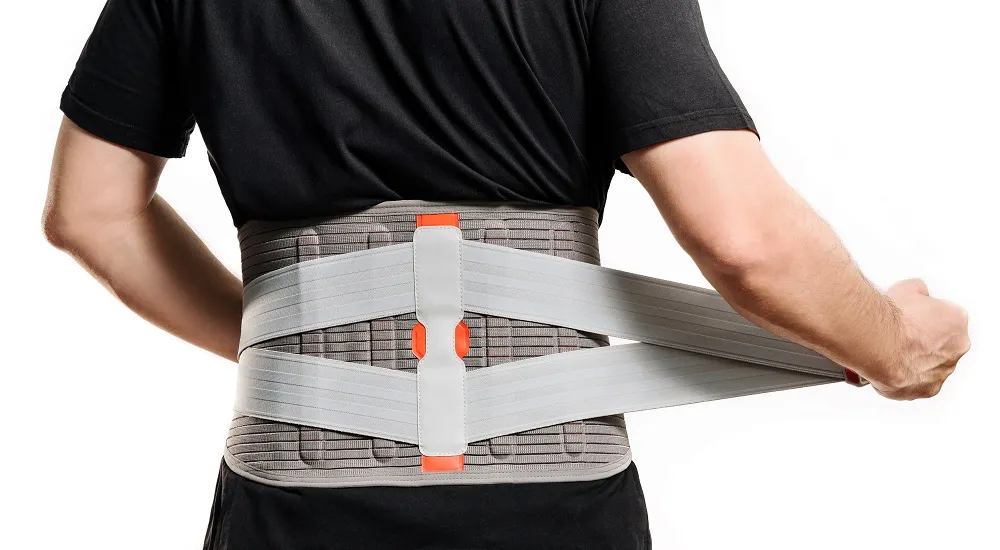
Wearing your back brace properly starts with the right preparation and positioning.
Start by wearing a fitted, moisture-wicking shirt as a base layer to prevent skin irritation and manage sweat buildup throughout the day. This base layer protects against skin rashes and helps prevent rubbing that can occur with direct contact.
Before putting on your brace, check the affected area for any existing irritated skin or open wounds. If you notice any concerns, consult your physical therapist before moving forward. The injured area should always be clean and dry to ensure your brace fits comfortably.
Follow the steps below to put the back brace on correctly:
- Position yourself standing with your spine in a neutral, comfortable position, and avoid sucking in your stomach or pushing it out.
- Hold the brace with the back panel centered on your spine, ensuring it will cover your lower back’s natural curve.
- Place the bottom edge of the lumbar brace at or just below your navel for proper lower back brace positioning.
- Wrap the wings around your torso, keeping side seams aligned with your pant seams to maintain proper alignment.
- Secure the front closures, starting with the bottom straps and working upward to provide even support.
- Pull the adjustment tabs evenly on both sides to achieve the desired compression and pressure without restricting breathing.
- Check that the brace covers your entire lumbar and sacral area while allowing you to move comfortably.
- Ensure the brace feels snug but not tight enough to cause pain or restrict circulation.
Before you reach behind to position the brace, remember that this movement can be painful with existing back pain. Don't hesitate to ask a family member or friend for assistance during the initial fitting process. If you wear the brace incorrectly, it could worsen your condition rather than promote the healing process.
Wearing a Back Brace: Duration, Timing, and Adjustments
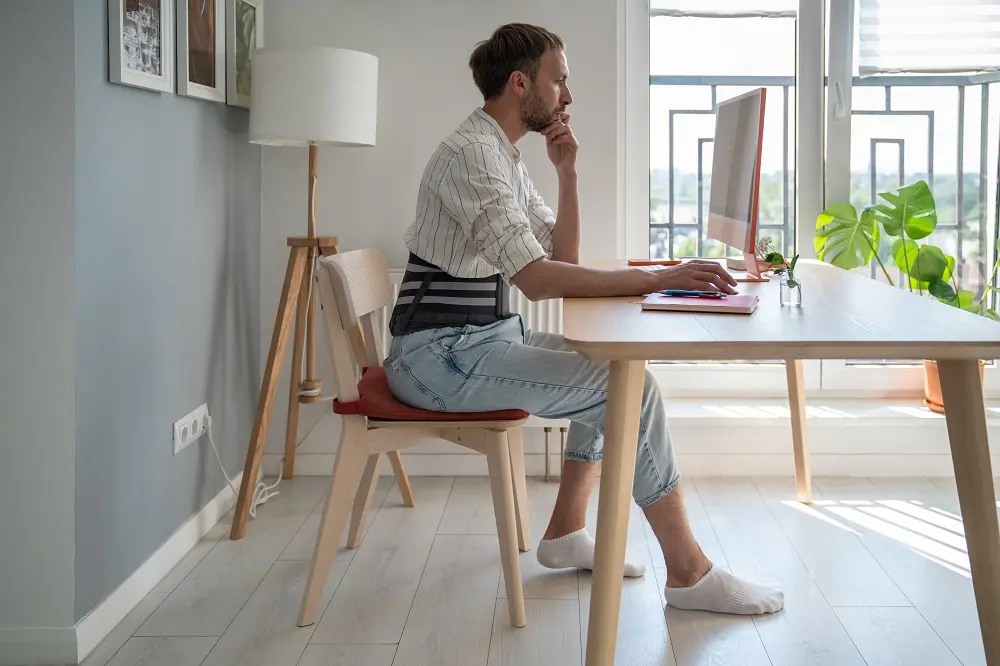
Learning how to wear a back brace effectively involves more than just putting it on correctly. The duration and timing of how you wear your brace significantly impact your healing process and overall comfort. Your treatment plan should include specific guidelines about when to wear a back brace and for how long, as using it improperly may lead to muscle atrophy or dependence on the device.
Daily Wearing Schedule
Most braces work best when worn during specific activities rather than continuously. Your physical therapist or doctor will provide specific guidelines, but general recommendations suggest wearing your brace for a few hours at a time during activities that typically trigger pain.
Ideally, you’ll start with shorter periods and gradually increase wearing time as your body adapts. Many people wonder if they can wear a back brace all day at work, and the answer depends on their specific condition. However, most professionals recommend taking breaks every few hours to allow your muscles to work independently and maintain strength.
For those recovering from injury or surgery, initial wearing might be limited to 2–3 hours daily, with wear gradually increasing as comfort improves. The goal is to provide support without creating dependence, allowing your back muscles to maintain their strength while getting the needed assistance during challenging activities.
When to Wear Your Brace
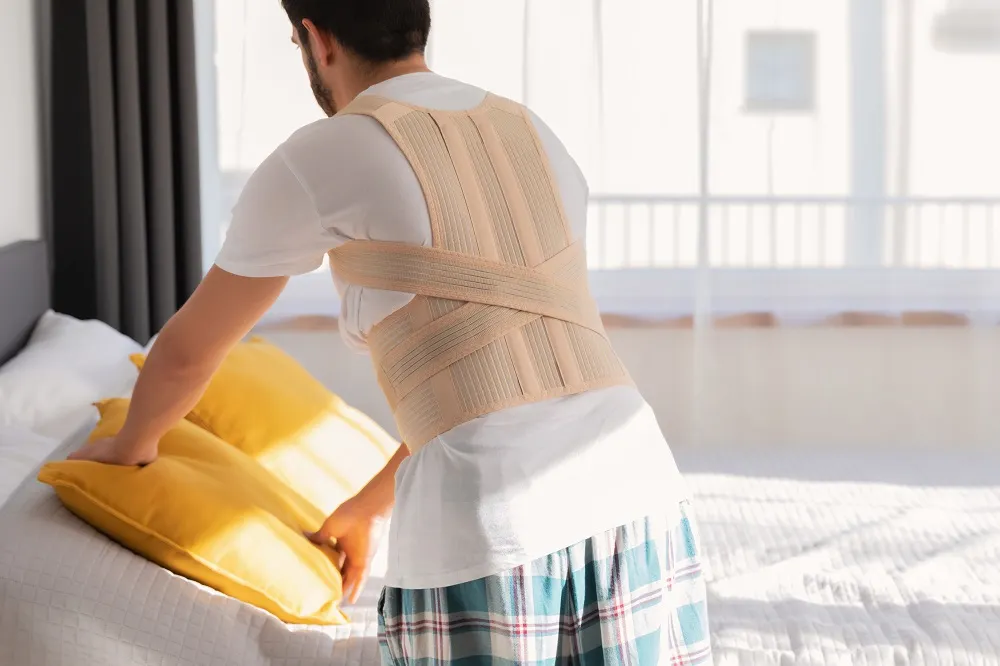
Optimal times for brace wearing include:
- During heavy lifting or physical labor to provide stability and reduce strain.
- While performing household chores that involve bending, especially when handling heavy objects.
- Throughout extended periods of sitting or driving to maintain good posture.
- When experiencing acute pain flare-ups, for immediate pain relief.
- During the initial weeks following injury or back surgery, as prescribed.
- While engaging in activities known to aggravate your condition.
- During physical therapy sessions, when your therapist recommends it.
The timing varies based on individual needs. Some patients benefit from wearing their lower back brace preventively before activities, while others find relief using it reactively when pain begins.
Sleeping with a Back Brace
Many patients wonder about nighttime brace use. While most braces should be removed for sleep to allow muscles to rest, some conditions require nighttime wearing. For example, adolescents with scoliosis often need to wear their brace 16–23 hours daily, including during sleep. Post-surgical patients may also need to wear their brace continuously during initial recovery.
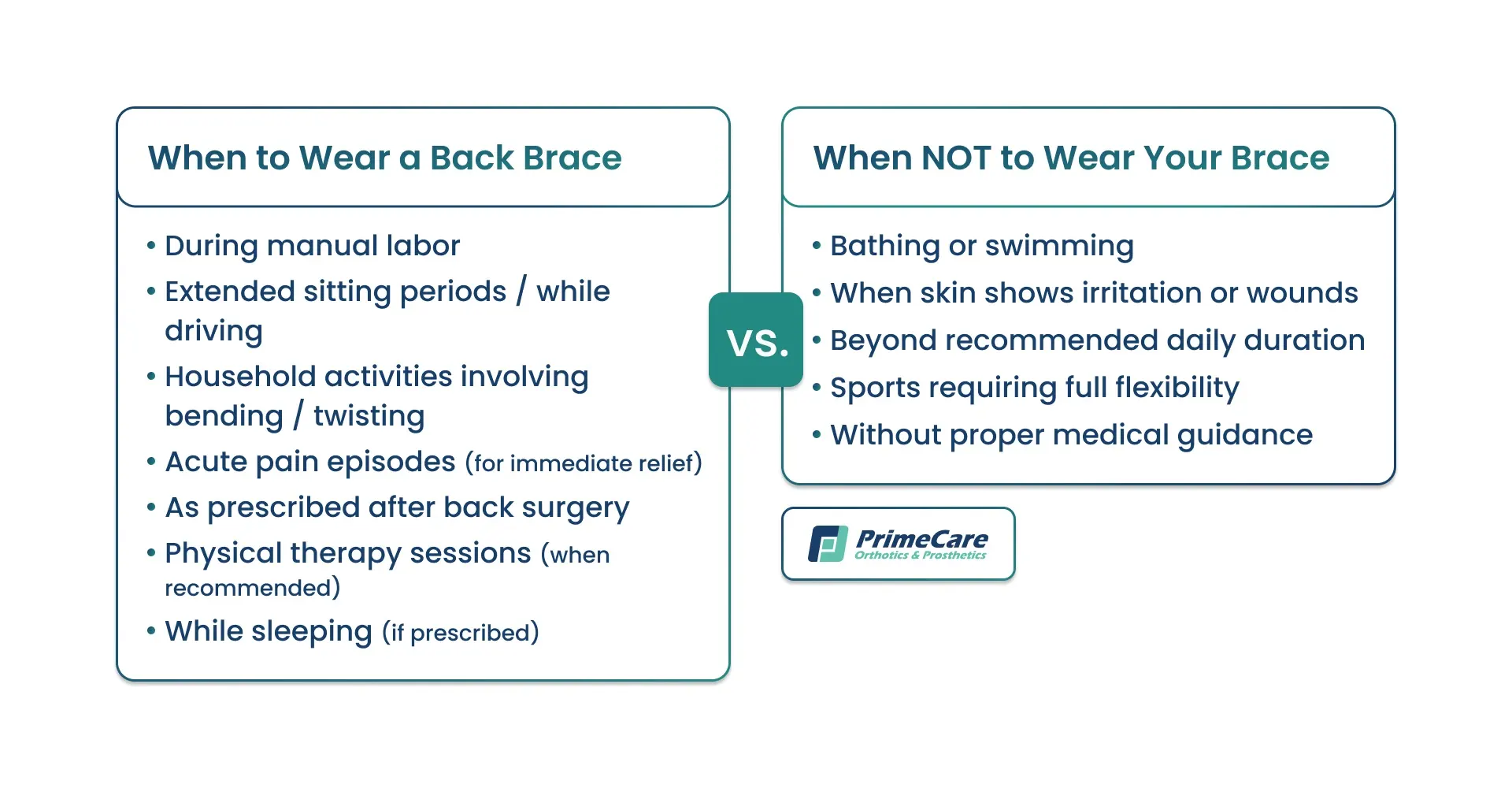
Making the Right Adjustments to Your Back Brace
Your comfort needs may change throughout the day as swelling fluctuates and muscles fatigue. The brace should feel snug enough to provide support without restricting breathing or causing discomfort. The last thing you want is to wear it incorrectly, as this can lead to further injury rather than promoting the healing process.
Adjust compression levels based on your activity. Compression should be tighter when lifting heavy objects to provide additional support, and looser for desk work to maintain comfort. Pay attention to pressure points and readjust if you notice any areas of excessive pressure or rubbing.
The goal is to improve posture and provide stability without compromising circulation or causing more discomfort. Regular adjustments throughout the day ensure consistent support while preventing complications stemming from improper fit.
Maximizing Back Brace Effectiveness: Tips for Daily Wear
Consistent care practices and attention to detail go a long way in achieving optimal benefits from your back brace. These strategies will help you avoid common issues while enhancing your overall comfort and support. Proper maintenance and wearing techniques ensure your brace continues to provide effective pain relief as your treatment plan progresses.
- Maintain skin health by cleaning the affected area daily with soap and water, paying special attention to areas where the brace creates pressure.
- Apply rubbing alcohol to your brace daily, allowing it to dry before wearing to prevent bacterial growth and odor.
- Rotate between two moisture-wicking base shirts to ensure you always have a dry layer and reduce the risk of skin irritation.
- Perform gentle core muscles strengthening exercises as your physical therapist recommends to prevent muscle atrophy during extended brace use.
- Take breaks every few hours to prevent rubbing and allow your skin to breathe, which is especially important during all-day wear.
- Monitor for persistent redness lasting over 30 minutes after removal, which may indicate improper fit or excessive pressure.
- Hand wash your brace weekly using mild soap to maintain its effectiveness and prevent odor buildup from regular use.
- Check straps and elastic components regularly for signs of wear that can compromise support.
- Keep a log of wearing times and any discomfort to discuss with your healthcare provider during follow-up appointments.
- Use proper lifting techniques even while wearing your brace; bend at the knees, not the waist, to protect your spine.
- Gradually reduce your dependence on the brace as your condition improves to encourage natural muscle strength.
Caring for your skin is essential, as it prevents irritation and potential skin rashes that can develop from prolonged wear. If you notice any skin irritation, remove the brace temporarily to let your skin heal before resuming use.
The goal is to wear a back brace as a tool for recovery, not as a permanent solution. Communicate with your healthcare team regularly to ensure you're using the brace appropriately for your specific condition.
Find Back Pain Relief Through Proper Brace Support
Wearing a back brace properly is only one part of how to manage back pain. While these devices provide stability and support, combining brace use with physical therapy, regular exercise, and good posture habits creates lasting relief.
At PrimeCare, we provide properly fitted, high-quality back braces with expert guidance and care throughout New Mexico. We’ve served over 30,000 patients and have over a decade of experience assisting patients with our custom orthotic solutions. Contact us today to schedule your consultation and learn how the right back brace, worn correctly, can reduce your pain and improve your quality of life.

.svg)
.svg)


